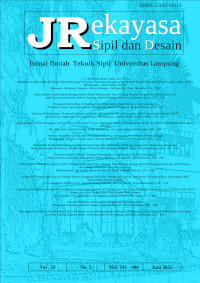Evaluasi Kinerja Struktur Gedung Bertingkat dengan Metode Analisis Time History (Studi Kasus: Apartemen Kingland Avenue Serpong)
DOI:
https://doi.org/10.23960/jrsdd.v9i1.1720Abstract Views: 203 File Views: 118 File Views: 0
Abstract
The high level of seismic activities in Indonesia causes the planning of building structures to be taken into account against the acceleration of the earthquake on the ground. Earthquake acceleration on the ground is an earthquake parameter that has a direct impact on the structure. Time history dynamic analysis can represent the dynamic properties of earthquake acceleration and structural response. So that this analysis method can provide a more complete description and information on structural responses. Earthquake recording data uses actual 3 earthquake accelerograms which are scaled with the planned earthquake response spectrum. From the results of this study, it is found that according to ATC-40 the building structure is included in the damage control category. Meanwhile, according to SNI 1726 (2019), the Chi-Chi and El Centro earthquakes met the requirements for deviation bricks between permit floors, but in the Kobe earthquake, the building structure did not meet the deviation requirements between permit floors on the 3rd floor.
Downloads
Downloads
Additional Files
Published
How to Cite
Issue
Section
License

JRSDD is licensed under a Creative Commons Attribution-NonCommercial 4.0 International License.

